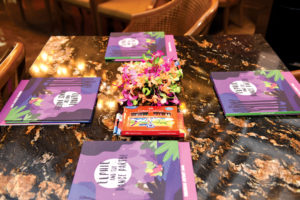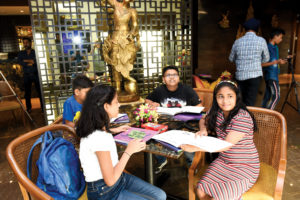Keshav Suri’s establishment Kitty Su, has adopted a practice only seen in the West this far. The drag queens performing at his club are now conducting story telling sessions for young children, and interacting with them as their drag personas
“My favourite colour is the whole rainbow!” a little child had exclaimed excitedly when asked what his favourite colour in the rainbow was. Needless to say, such enthusiastic responses from young children are very fulfilling for the drag queens who conduct these sessions.
Betta Naan Stop and Lush Monsoon, two of the regular performers at Kitty Su, have conducted the first two storytelling sessions thus far, and hope that the initiative snowballs into a much bigger affair with time. The turnout at the very first session was an impressive 30-35 children who came accompanied with their parents.
“When I found out this was being launched in Delhi, I was immediately up for it,” says Prateek Sachdeva, who performs as Betta Naan Stop at Kitty Su. He admits with a laugh that he wasn’t very fond of children until his nephew came along, and now he thoroughly enjoys spending time with the kids at the sessions.
The stories they read out are a two-part series about a rainbow coloured elephant called Elphie, who struggles with his identity as he is different from all of the grey elephants. The first part is about self acceptance while the second is about being differently abled in a dichotomous world. “The peacocks that Elphie encounters when he gets lost in the jungle are the representation of drag queens in the story!” Prateek provides excitedly.

Prateek confesses that he had been really nervous before the first session. He is a trained dancer and is not new to performing on stage, “But the club crowd is very different,” he explains. “Kids are a very different kind of audience.” He talks about how it’s more of a boon than a bane that children come in with no context whatsoever, to simply listen to stories and internalise the values in it. His hope for the future is that these stories can be diversified in different languages so as to reach children all over the country.
“I want my child to grow up with the understanding that gender is only a construct,” says Swati Jain, who took her son for a session. “We live in a world where there is a lot of pressure on kids, whether it be from friends or parents.” She elaborates that parents these days are not able to adequately monitor the information their children have access to. There is an overload of information that the children take in without really considering. “So introducing them to a concept for the first time in this way in a great way to educate them.”
Jain recalls the Run Like A Girl Campaign and talks about how telling a person’s conditioning can be, based on the community they grew up in. She stresses that most importantly, she does not want her son to be bullied or become a bully in the future.
“We had to put a lot of thought into making drag attractive for children. They respond to different visuals than grownups do,” says Ayushman, who transformed into his drag avatar Lush Monsoon for the session, entertaining questions about his outfit and his wig. “The idea is to show them someone who doesn’t look like them or their parents, and establish that there isn’t much difference in the people,” he elucidates.
Ayushman has received very favourable feedback from the parents and was pleasantly surprised along with his colleague at the way the parents were handling the affair. “They were more excited than the children actually,” he reveals, “encouraging their kids to shake our hands and take pictures with us. They even said they’d like us to conduct more such sessions for their children.” Ayushman stresses on the vast difference between performing for an already conditioned audience (adults) versus performing for one that’s not. The children react immediately and allow you to change their mindsets without arriving at their own conclusions based on outside factors. This makes telling stories to children in drag doubly satisfying.
Richa Jain, took Vedant, her ten-year-old son, for the first session on April 13. “What I really appreciate is that it is done subtly, and not in a way that’s in your face,” she says. She explains that she wants her child to know that it’s okay to be different, and no part of anyone’s personality is based on how they look or how they are dressed. “I want him to broaden his horizons.”

Singh also agrees that the same book if printed in Hindi and distributed in government schools would make worlds of difference and really elevate the education system. The fact that drag queens – men who are considered the epitome of dressing and living outside the box – are being employed to conduct these story sessions. They are imparting values that they have lived by and telling simplified versions of their own stories, and that carries all the extra weight.
Even though the same initiative had prompted some protests in the US, the skies are only looking sunny for now in India. The sessions have been conducted in a few states over the country as well as one in London and the feedback has been beyond overwhelming for the drag queens. Parents have brought their children back for repeat sessions, with the children eager tagging along for an evening of fun and learning. It occurs to one, that a project such as this can only spell good things for the future of our children. Acceptance and tolerance – the pillars of their value system.





